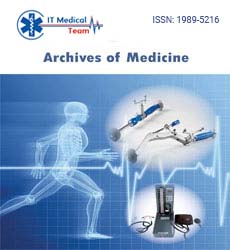Opinion - (2022) Volume 14, Issue 6
Causes of hemiplegic cerebral palsy and its management
Pascal David*
Division of Pediatric Neurology, Indiana University, School of Medicine, Indianapolis, Indiana
*Correspondence:
Pascal David, Division of Pediatric Neurology, Indiana University, School of Medicine,
Indianapolis,
Indiana,
Email:
Received: 25-May-2022, Manuscript No. ipaom-22-12949;
Editor assigned: 28-May-2022, Pre QC No. P-12949;
Reviewed: 17-Jun-2022, QC No. Q-12949;
Revised: 22-Jun-2022, Manuscript No. R-12949;
Published:
30-Jun-2022
Abstract
A retrospective population-based study of 169 instances with
hemiplegic cerebral palsy (CP) from the South-western Swedish
health care region covering the birth years 1969-1978 was
conducted. The goal was to look at the prevalence, aetiology, and
neurodevelopmental outcomes in preterm and full-term babies,
as well as correlate pathogenetic periods, etiological factors, and
clinical parameters to neuroradiology. The frequency was 0.66 per
1000 between the ages of 6 and 15. Postnatally acquired hemiplegia
accounted for 11% of the total, with the majority of cases being
postinfectious, iatrogenic, or posttraumatic. Prenatal (primarily
circulatory brain lesions and maldevelopments) was the aetiology
in 42 percent of term children with congenital hemiplegia (pre
and perinatally derived), combined pre and perinatal in 9 percent,
perinatal (cerebral haemorrhage, hypoxia) in 16 percent, and
untraceable in 34 percent.
Keywords
Communicable disease; Mouth; Nose; Eyes
Introduction
The overall handicap was classified as light in 40% of the
cases, moderate in 44%, and severe in 16%. Postnatal cases
had the highest rate of severe complete disability. In 109
congenital instances, Computerised Tomography (CT)
revealed cortical/subcortical cavities in 20%, unilateral
ventricular enlargement in 36%, and cortical/subcortical
cavities in 26%. The remaining 18% of CT findings
were categorised as "other." The associations between CT
findings and aetiologies were inadequate and disappointing
with the categories utilised so far. CT findings, on the
other hand, were found to have a substantial association
with the clinical severity of the impairment and its size.
Normal CT was typically associated with mild disability
and moderate unilateral ventricular enlargement, whereas
cortical/subcortical cavities were usually associated with
severe impairment, such as mental retardation and epilepsy.
About the Study
Preterm children had a similar distribution, with 29
percent, 47 percent, 25 percent, and 6%, respectively.
Preterm birth was found to be 24 percent of the time in
congenital instances. Birth asphyxia was found to be a poor
predictor of pathogen etic phase, but a series of postpartum
problems pointed to perinatal brain injury. A clinical
follow-up of 152 children found that 50% had mild motor
dysfunction, 31% had moderate motor.
Dysfunction and 19% had severe motor dysfunction.
In 44 percent of the children, stereo gnostic sensibility
was affected (astereognosia in 20 percent). Additional
disabilities (mental retardation, epilepsy, impaired vision,
hearing and speech, severe behavioural/perceptual issues)
were found in 42 percent of the participants. Preterm
children with congenital hemiplegia were more seriously
affected than term children with congenital.
Classification
Cerebral palsy is classified based on how it affects
people's movement, the body portion affected, and the
severity of the effects [1]. Ataxic cerebral palsy: Clumsiness,
imprecision, and instability are all characteristics of ataxic
movements. The movements are not smooth and may
appear choppy or dis organized. When a person with ataxia
tries to make voluntary motions like walking or picking
up objects, they experience incoordination. Ataxia is
characterized by a loss of muscle control in the arms and
legs, which leads to a loss of balance and coordination.
Ataxia patients may have the following
symptoms
Tremor or unsteady, wobbly movements: Maintaining
equilibrium is difficult. Because their sense of balance and
depth perception are compromised, people with ataxia
appear unsteady and shaky. Dyskinetic cerebral palsy:
People with dyskinetic cerebral palsy exhibit involuntary
movement that is varied (outside of their control). When
a person tries to walk, these involuntary motions become
more obvious.
Dyskinetic motions can include the
following:
Dystonia is a condition that causes twisting and
repetitive movements. Athetosis is a term for slow, 'stormy'
movements. Chorea is a dance-like movement that is
irregular and unpredictable .Spastic cerebral palsy: The
most prevalent type of cerebral palsy is plastic cerebral
palsy. People with spastic cerebral palsy have tight muscles,
and their motions may appear stiff and jerky. Hypertonia,
or increased muscular tone, is a type of spasticity. As a
result, muscles become rigid, making movement difficult,
if not impossible [1-5].
Conclusion
Subsequently, potential treatment activities and
approaches ought to be created. The world is taking
essential preventive measures to minimize infective agent transmission. Convalescent plasma therapy is highly
suggested, because it has provided moderate success with
COVID-19 virus strains. COVID-19 could provide
some natural protection, called immunity. Current
proof suggests that reinfection with the virus that causes
COVID-19 is unusual within the ninety days when initial
infection. However, consultants don’t understand needless
to say however long this protection lasts, and also the risk
of severe illness and death from COVID-19 way outweighs
any advantages of resistance. COVID-19 vaccination can
facilitate shield you by making associate protein response
while not having to expertise illness.
Conflicts of Interest
The authors declare no competing interests.
All authors declare that the material has not been
published elsewhere, or has not been submitted to another
publisher.
Data Availability
Authors declare that all related data are available
concerning researchers by the corresponding author's
email.
Acknowledgments
The views presented in this paper are of the authors and
not of the organizations they represent.
REFERENCES
- Spital A, Valvo JR, Segal AJ. Nondilated obstructive uropathy. Urol. 1988;3:478-482.
Crossref, Google Scholar
- Onuigbo MAC. Symptomatic uremia from bilateral obstructive uropathy secondary to metastatic urinary bladder cancer showing only unilateral hydronephrosis: A case report. NDT Plus. 2009;2:387-389.
Crossref, Google Scholar, Indexed at
- Lameire N, Van Biesen W, Vanholder R. Acute renal failure. Lancet. 2005;365:417-430.
Crossref, Google Scholar, Indexed at
- Naidich JB, Rackson ME, Mossey RT, et al. Nondilated obstructive uropathy: Percutaneous nephrostomy performed to reverse renal failure. Radiol. 1986;160:653-657.
Crossref, Google Scholar, Indexed at
- Lyons K, Matthews P, Evans C. Obstructive uropathy without dilatation: A potential diagnostic pitfall. Br Med J. 1988;296:1517-1518.
Crossref, Google Scholar, Indexed at






